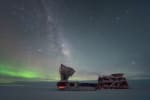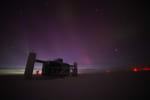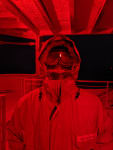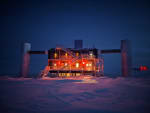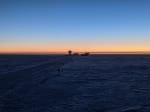Finally more stars and auroras can be observed at the South Pole as the sky continues to get darker and darker. With hardly any wind last week, which makes it more comfortable to be outdoors, IceCube’s winterovers enjoyed some time just staring up at the sky. Getting a good view of the Milky Way has […]
News
Week 17 at the Pole
IceCube’s winterovers were out at the IceCube Lab (ICL) for some troubleshooting last week, and they captured a few different views of the ICL in photographs. Above, the lingering light along the horizon still seems quite strong. Below, the stars are more apparent and there is a wisp of an aurora overhead. We get more […]
Week 16 at the Pole
Last week at the Pole was a quiet one for the IceCube detector. The IceCube winterovers, on the other hand, kept busy with various activities. They continued their inventories at the IceCube Lab (ICL). That’s Moreno above, decked out in his cold weather gear. The walk from the station to the ICL is about a […]
Week 15 at the Pole
It’s finally getting dark at the Pole. Last week, IceCube winterovers went out to the IceCube Lab to do some inventory and check on the wind turbine on the roof. While there, they also covered up the windows to prevent light pollution during the dark winter. They are in the Dark Sector after all. But […]
Week 14 at the Pole
Last week at the Pole brought claims of auroras in the skies overhead. No photos to go with those claims—not yet anyway, but those will surely come in the days ahead. In the meantime, the clear sky (without auroras) was beautiful in its even and gradual gradation from blue to orange along the horizon. And […]
Week 13 at the Pole
Ahh…twilight—that magical time when our surroundings seem to soften under the diminishing light of day. At the South Pole, twilight is a lengthy process that can take weeks, with the distant horizon still lit by the slowly setting sun. They’ll begin to see a few stars, and maybe some auroras, before full darkness envelopes the […]
Week 12 at the Pole
As with the previous week, last week’s weather at the Pole was a little cloudy, not the best for getting good glimpses of the one-and-only sunset (it will be a while before they see the sun again). Fortunately, there were a few moments when the skies cleared, and most of the crew took the opportunity […]
Week 11 at the Pole
Long shadows are getting even longer. The sun hasn’t quite set completely at the Pole, but it’s very close. The weather last week was rather cloudy and windy. If it continues like that next week, the skies might be uncooperative for getting nice sunset photos. In the meantime, the images here were captured in a […]
Week 10 at the Pole
IceCube’s winterovers started off last week with continued detector troubleshooting from the previous week. Later in the week, they joined a South Pole webcast and gave an outreach presentation on their experience as winterovers. They also took advantage of being outdoors for some emergency response training to trek out to the IceCube Lab and get […]
Are extragalactic sources of ultra-high-energy cosmic rays efficient emitters of neutrinos?
The search for the sources of ultra-high-energy cosmic rays (UHECRs) is not a simple one. UHECRs, which are a mixture of protons and heavy nuclei, are the highest energy particles ever measured. They should produce “hotspots” of high-energy neutrinos if they interact with other particles near their point of origin. Six years ago, a first […]
